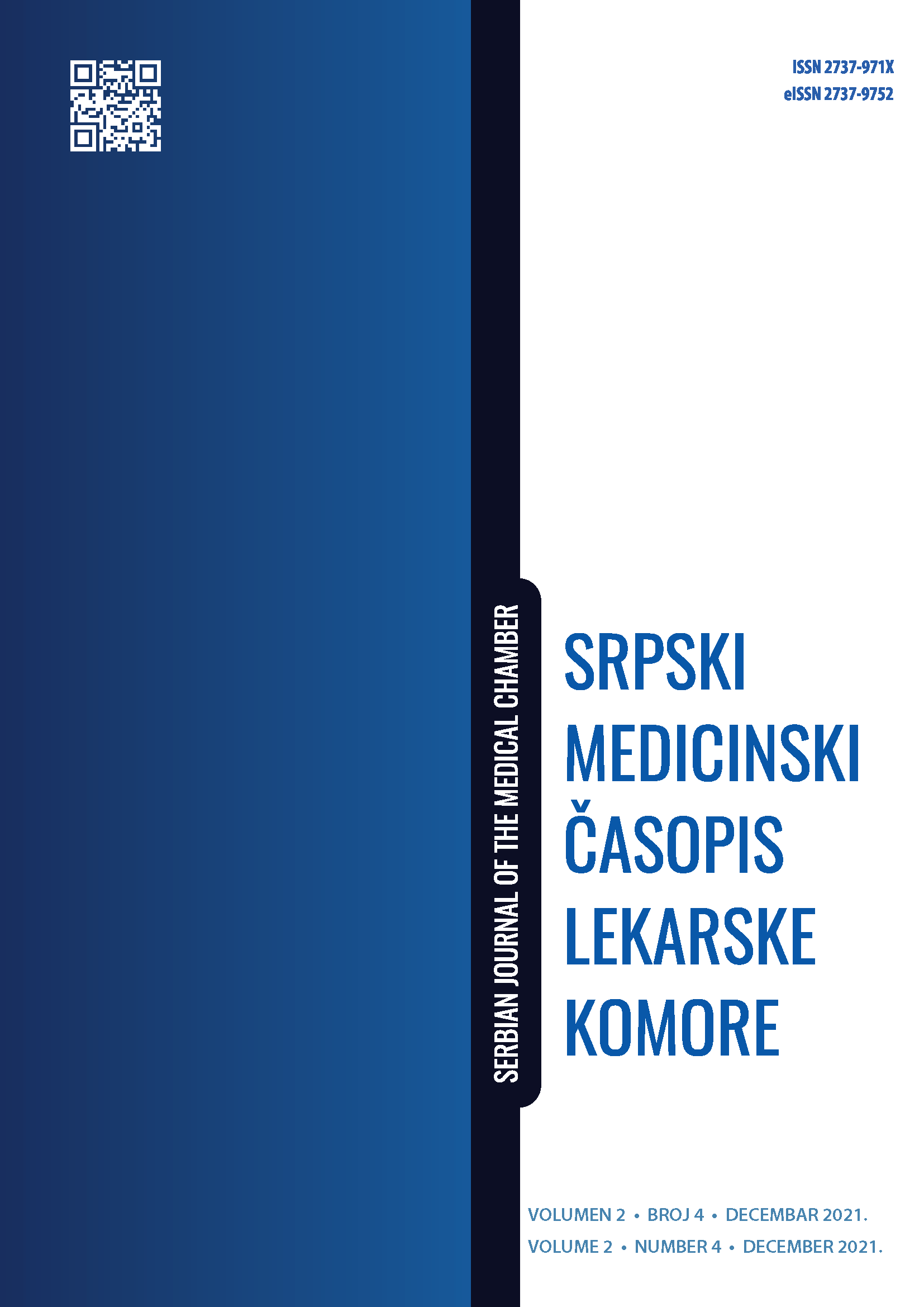SPONTANEOUS RETROPERITONEAL HEMATOMA IN A COVID-19 PATIENT
Abstract
Introduction: The infection caused by the SARS-CoV-2 virus is known to cause a hypercoagulable condition resulting in acute thrombotic events. Thromboembolic events occur in as many as 21.0% of cases with a mortality rate of about 74.0% in persons infected with COVID-19. Anticoagulant therapy is used in severe
COVID-19 infections in order to prevent thrombosis and has been shown to reduce mortality. The use of anticoagulants is not without risks. Bleeding complications can range from mild to severe or even life-threatening, such as retroperitoneal bleeding into the psoas muscle.
Case report: We present a case of a patient who developed a complication of bleeding into the retroperitoneal space during the treatment of bilateral bronchopneumonia caused by the SARS-CoV-2 virus. After the diagnosis was established, on the basis of a clinical examination, laboratory and radiological examinations, and after initial conservative treatment at the UHMC Bežanijska kosa, the patient
underwent embolization of the left lumbar arteries from the right inguinal fossa, during procedural analgosedation. After the radiological procedure, the recovery was satisfactory, but due to the impossibility of resorption of an encapsulated hematoma with a zone of central necrosis, a mini left lumbotomy and evacuation of the hematoma were performed. The patient was discharged from the hospital
on the 23rd day of admission in stable general condition.
Conclusion: The effect of anticoagulant therapy, especially in patients with existing risk factors, early diagnosis, and prompt therapy of spontaneous retroperitoneal hematomas is imperative to reduce mortality from this severe complication, in patients with the COVID-19 infection.
References
2. Malas MB, Naazie IN, Elsayed N, Mathlouthi A, Marmor R, Clary B. Thromboembolism risk of COVID-19 is high and associated with a higher risk of mortality: a systematic review and meta-analysis. EClinicalMedicine. 2020;29:100639].
3. Al-Samkari H, Karp Leaf RS, Dzik WH, et al.: COVID and coagulation: bleeding and thrombotic manifestations of SARS-CoV2 infection. Blood.2020, 136:489-500. 10.1182/blood.2020006520
4. Levi M, Thachil J, Iba T, Levy JH: Cogulation abnormalities and thrombosis in patients with COVID-19. Lancet Haematol.2020,7:438-440. 10.1016/S2352-3026(20)30145-9.
5. Ackermann M, Verleden SE, Kuehnel M,et al.: Pulmonary vascular endothelialithis, thrombosis, and angiogenesis in Covid-19. N.Engl J Med. 2020;383:120-128. 10.1056/NEJMoa2015432.
6. Shah A, et al. 2020. Thrombotic and haemorrhagic complications in critically ill patients with COVID-19: a multicentre observational study. Crit Care. 2020;24: 561. 10.1186/s13054-020-03260-3.
7. Erdinc B, Raina J S. Spontaneous Retroperitoneal Bleed Coincided With Massive Acute Deep Vein Thrombosis as Initial Presentation of COVID-19. Cureus. (August 15, 2020);12(8): e9772. DOI 10.7759/cureus.9772.
8. Artzner T, Clere-Jehl R, Schenck M, et al. Spontaneous ilio-psoas hematomas complicating intensive care unit hospitalizations. PLoS One. 2019;14(2):e0211680. Crossref. PubMed.
9. Vergoria A, Pianurab E, Lorenzinia P, D’Abramoc A, Di Stefanob F, Grisettia S, Vitac S, Pinnettia C, Donnod DR, Marinie MC, Nicastric E, Ianniellob S, Antinoria A, and on behalf of the ReCOVeRI Study GroupS. Spontaneous ilio-psoas haematomas (IPHs): a warning for COVID-19 inpatients. ANNALS OF MEDICINE. 2021; 53(1): 295-301.https://doi.org/10.1080/07853890.2021.1875498.
10. Patel I, Akoluk A, Douedi S, Upadhyaya V, Mazahir U, Costanzo E, Flynn D, 2020. Life-threatening psoas hematoma due to retroperitoneal hemorrhage in a COVID-19 patient on enoxaparin treated with arterial embolization: a case report. J Clin Med Res.2020; 12(7): 458–461. 10.14740/jocmr4256.
11. Llitjos JF, Daviaud F, Grimaldi D, Legriel S, Georges JL, Guerot E, Bedos JP, Fagon JY, Charpentier J, Mira JP. Ilio-psoas hematoma in the intensive care unit: a multicentric study, Ann Intensive Care. 2016; 6: 8. Published online 2016 Jan 19. doi: 10.1186/s13613-016-0106-z.
12. Surani S, Estement B, Manchandan S, Sudhakaran S, Varon J. Spontaneous extraperitoneal lumbar artery hemorrhage. J Emerg Med. 2011;40(6):e111–114. doi: 10.1016/j.jemermed.2008.01.029. [PubMed] [CrossRef] [Google Scholar]
13. Qanadli SD, El Hajjam M, Mignon F, Bruckert F, Chagnon S, Lacombe P. Life-threatening spontaneous psoas haematoma treated by transcatheter arterial embolization. Eur Radiol. 1999;9(6):1231–1234. doi: 10.1007/s003300050824.
14. Amole AO, Kathuria MK, Ozkan OS, Gill AS, Ozkan EO. Lumbar artery laceration with retroperitoneal hematoma after placement of a G-2 inferior vena cava filter. Cardiovasc Intervent Radiol. 2008;31(6):1257–1259. doi: 10.1007/s00270-008-9365-x.
15. Chan YC, Morales JP, Reidy JF, Taylor PR. Management of spontaneous and iatrogenic retroperitoneal haemorrhage: conservative management, endovascular intervention or open surgery? Int J Clin Pract. 2008;62(10):1604–1613. doi: 10.1111/j.1742-1241.2007.01494.x.

